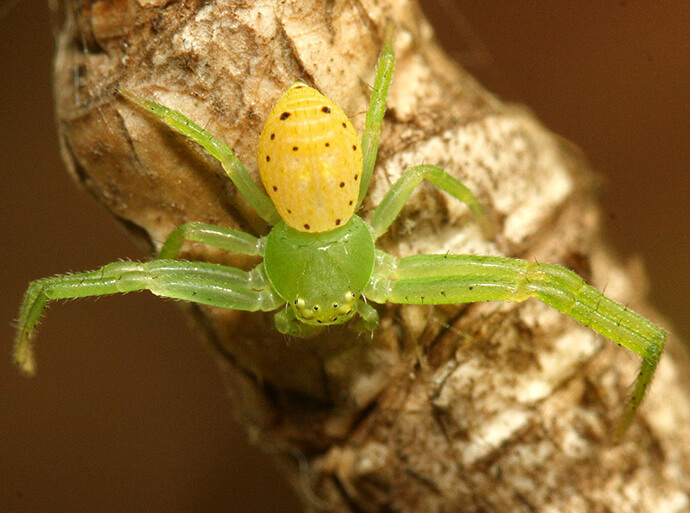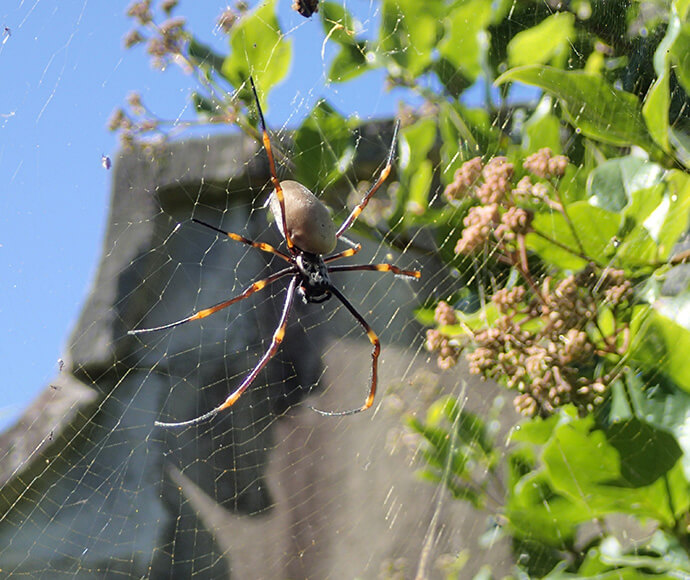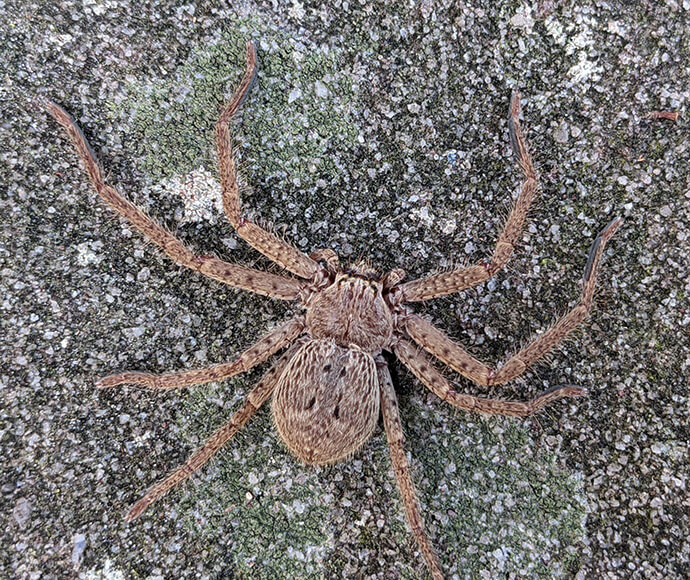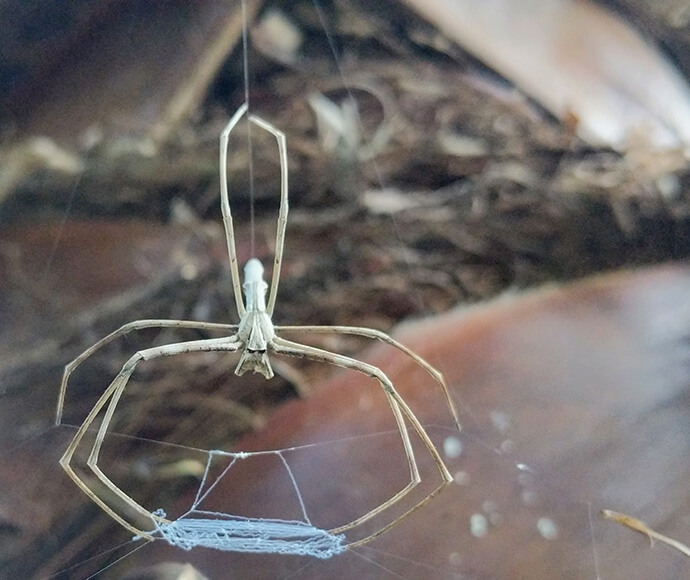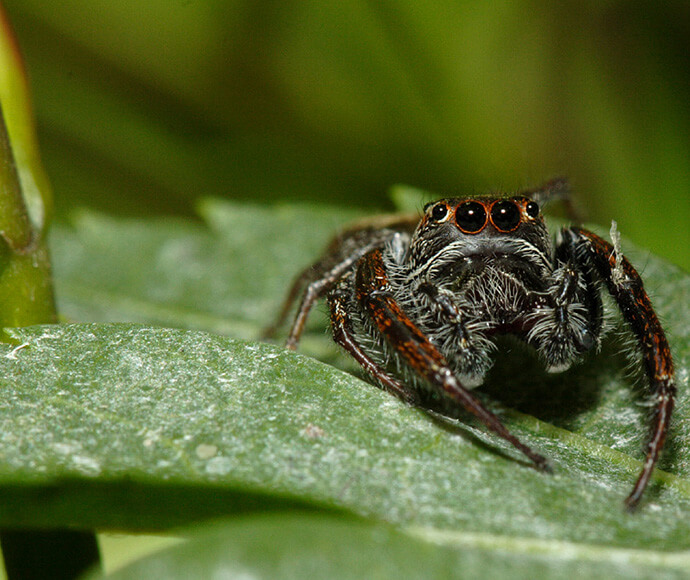Spiders are some of our best allies in the fight against insect pests which cause damage and disease in cities.
Often misunderstood, spiders are a vital part of Sydney’s ecosystems and actually help us out more than most people might realise. They are fascinating creatures with a stunning variety of shapes, colours and behaviours, and you can find many of them in your own backyard!
Important allies
Spiders are the primary terrestrial insect predator on Earth. They have been evolving strategies to catch and eat insects for millions of years, which makes them a wonderful ally in pest control.
Without spiders, the population of pest insects around the world would explode.
Spiders also help control insects that can harm humans, such as flies, cockroaches and mosquitoes, and limit the diseases that these pests can spread.
On farms, spiders help control pests that damage crops. They provide a natural pest control service that enables farmers to reduce the amount of pesticides they use to produce our food. Spiders also provide a source of food for other animals such as birds, lizards and small mammals.
Common Sydney spiders
Spiders are a diverse group. Over 40,000 species have been identified in the world. In Australia we know of over 3,500 species, but there are likely to be more than double that number which haven’t been described yet. You could even find a new species in your backyard – although most spiders will run away at the sight, sound or smell of a human!
Orb weaving spiders are the most widely recognised because of their large, stereotypical wheel-and-spoke style webs.
Garden orb weavers, golden orb weavers, leaf curling spiders, St Andrew’s cross spiders and silver orb weavers are easy to see. These spiders sit in their web and wait for prey to come to them. They are not aggressive and are a favourite of spider watchers of all ages.
Golden orb weaving spiders do particularly well in Sydney city. They build huge webs that span across roads and between trees near the coast and the botanic gardens. They often choose highly populated areas to live, and research has shown that they grow larger when they live in the city.
Another common type of orb weaving spider that is not as easy to spot is the bird dropping spider. These spiders disguise themselves as bird poo and do such a good job that they are very difficult to find.
Spiders such as funnel webs, trap door and mouse spiders are mygalomorphs, an ancient group of spiders. These spiders are large and heavy bodied but rarely seen because they live in long burrows in the ground. They catch their prey using ‘trip lines’ which extend out from their burrow entrance and alert them to insects crawling nearby.
The home of the Sydney funnel web spider is often confused with that of the trapdoor spider, but the trapdoor spider burrow will often have a trapdoor whereas funnel web burrows will not.
The Sydney funnel web spider is venomous. These spiders have toxic fast-acting venom, but they only bite as a last resort. Human–spider interactions with the Sydney funnel web typically occur during summer, which corresponds to when males are looking for females. Their slow speed, the time they take to rear up and strike, and the fact they are often in their burrows, means the odds of you ever interacting with one are very low.
Since the introduction of an antivenom in 1981 no deaths have been reported.
Huntsman spiders are large, long-legged spiders that have a reputation for appearing in houses, apartments and cars with the aim of jumping at and scaring the occupants.
Many huntsman spiders have flattened bodies, which enables them to live in narrow spaces. They are commonly found in rock crevices, wood piles and garden sheds around Sydney.
In reality these spiders are fast moving, but not aggressive. They have bad eyesight and will often accidentally run towards humans rather than away when frightened.
Huntsman spiders are expert cockroach and mosquito catchers, so if you find one in your house consider yourself lucky that you have a live-in pest controller! They are mostly brown or grey, some are green. They can have different patterns and colours on their abdomen and legs.
Like all spiders, huntsman moult to grow. You might find an old skin that a huntsman spider has shed hanging from the ceiling or a branch in your garden.
Another common spider in urban gardens is the net-casting spider. They have stick-like bodies, skinny legs and are often found hanging upside down in foliage holding their ‘net’ with their front two legs and waiting for prey.
These spiders hang upside down in vegetation when resting, their front and back legs held together, which makes them appear like a stick.
Net-casting spiders are nocturnal. They have huge eyes with excellent eyesight to see prey at night and to accurately calculate the distance they need to throw their nets and catch their prey.
Jumping spiders are usually small, active and curious with strong back legs giving them the ability to jump large distances.
You will see them hopping around on grass or foliage looking for small flies to pounce on.
They have large eyes with excellent vision to calculate distance and catch prey. They will often sit and watch you if you take the time to say hello.
These spiders can be beautiful colours – perhaps the most famous (and fabulous) jumping spider is the peacock spider.
Male peacock spiders have a brightly coloured abdomen which they will flare out in a stunning display, accompanied by drumming their legs, to attract a female.
Peacock spiders have only recently been discovered by Western science, and if you take the time to look you'll find them in many areas around Sydney. Biologist Joseph Schubert and citizen scientist group Project Maratus are working to discover more.
Lynx spiders travel around to find their prey rather than sitting in a web. They are common in urban gardens and many have colourful striped abdomens.
Instead of using accurate eyesight like jumping spiders to locate their food, lynx spiders feel the vibrations of prey through their spiky leg hairs. When they detect prey they leap out to catch it.
Crab or flower spiders don’t use a web or jump to catch their prey, they are sit-and-wait predators. They camouflage themselves within flowers, and wait for unsuspecting pollinators to visit before using their large front legs to catch them.
Some of these spiders can change colour to match the flower they’re sitting on.
If you’re out at night and see a spider move quickly underfoot or catch a twinkle of eye shine in your torch, chances are you’ve seen a wolf spider. These spiders are common, especially in open grassy areas and places with lots of leaf litter. They live in burrows in the ground and come out to hunt their prey.
One characteristic behaviour of wolf spiders is that the mothers carry their egg sacs around with them. Once the babies hatch she carries the babies on her back until they’re large enough to fend for themselves.
Help our native spiders
It’s okay to have insects and spiders in your garden!
Steps you can take to make sure spiders survive outside and continue to provide us with benefits, such as preserving the balance in insect numbers and avoiding pest outbreaks, include:
Do not spray pesticides outside. Pesticides kill insects that would have been a food source for spiders. Without a food source spiders will starve or move away. Broad-spectrum pesticides will also kill off beneficial insects and spiders in your garden. This can result in only hardy pest insects in your garden, and with no natural predators or beneficial insects this gives pest insects the opportunity to thrive.
Encourage insects (aka spider food) by providing plant resources, especially native plants. Providing food as well as places to live, rest and hide are important support for insects in your garden. For example, this could include trees and plants of different sizes. The goal is to create environmental complexity. This means adding layers to your garden such as logs, rocks, leaf litter, flowering plants, small shrubs, trees; whatever will fit in to provide habitat for spiders and their prey.
Do not remove spiders or damage their homes. An easy way to help spiders do their important jobs is to preserve their habitat. The outside world, which includes your garden, is their natural habitat. Unless you have identified spiders as dangerous, leaving them where they are is the best way to let them happily do their job.
What spiders eat
Most spiders are generalist predators, which means they eat a variety of prey. However, different groups of spiders use different hunting methods to catch their prey.
Spiders are loosely grouped into 2 predator groups:
- active ambush hunters
- sit-and-wait, on a web, down a burrow, on a flower or other foliage.
Where spiders live
Where a spider lives depends on how they catch their prey.
Active hunters do not make webs and live in burrows or funnels in the ground or under logs. For example, huntsman and wolf spiders.
Sit and wait predators make and live in webs to catch their prey. These spiders need lots of vegetation (or buildings!) as attachment points for their webs, such as orb-weaver spiders.
Some spiders have unique and interesting homes. For example:
- Leaf-curling spiders curl up and suspend a leaf in their web so they have somewhere to hide from predators.
- The web of the St Andrew’s cross spider is easily identified by the cross shape they weave into it, which is thought to attract flies and deter birds.
- Jumping spiders don’t use webs to catch prey, but they do build little silk tents between leaves to sleep in and lay their eggs.
What to do if you come across a dangerous spider
Although most spiders are venomous – they use their venom to subdue their prey – very few cause risk to humans.
Spiders known to bite humans but are not medically significant include wolf, mouse, huntsman, white tailed and black house spiders.
White tailed spiders are easily identified by their cylindrical body shape and distinctive white or grey spot on the end of their abdomen. They are active hunters and prey on other spiders. They may be found inside houses, but white tailed spiders are not venomous to humans.
Always err on the side of caution and don’t handle these types of spiders.
Two species to be extra cautious about are redback and funnel web spiders – both cause nasty bites.
A funnel web spider bite can be life threatening.
Visit NSW Poisons Information Centre for more information or ring the Poison Information Hotline on 13 11 26.
Redback spiders are easily identified by their messy webs and round black bodies with a distinctive red stripe.
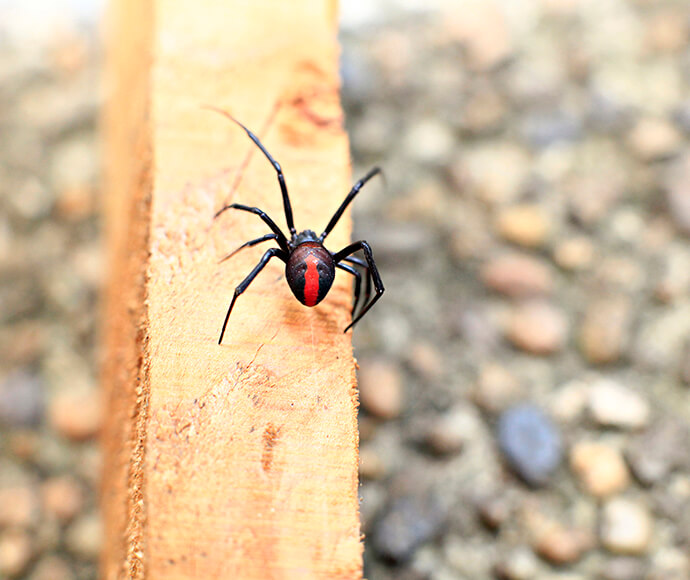
Redback spider (Latrodectus hasselti)
Funnel web spiders can be difficult to identify, even for experts. They have a similar large chunky body to many other ground-dwelling spiders such as trapdoor, mouse and black house spiders. An important point is that they only ever make their funnel-like webs in the ground.
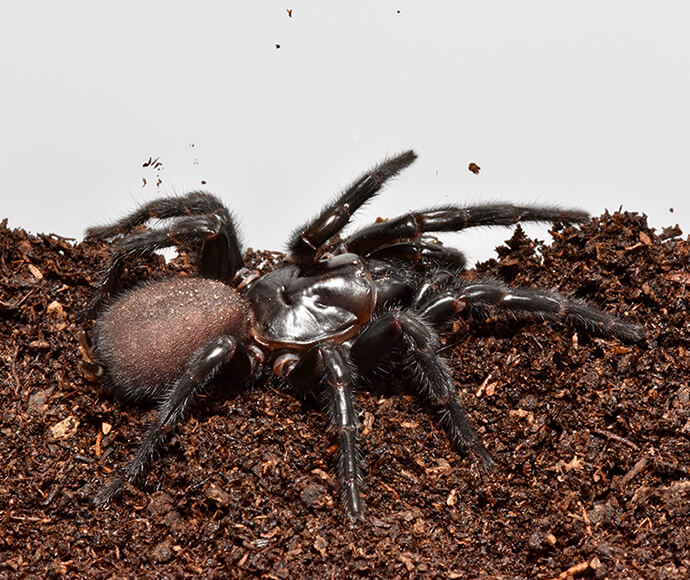
Sydney funnel-web spider (Atrax robustus)
Black house spiders are sometimes mistaken for funnel webs when people see their cylindrical webs in garages or on window panes. But funnel webs are much larger spiders and only build their webs in the ground, most frequently under logs and lots of leaf litter.
If in doubt, stay away.
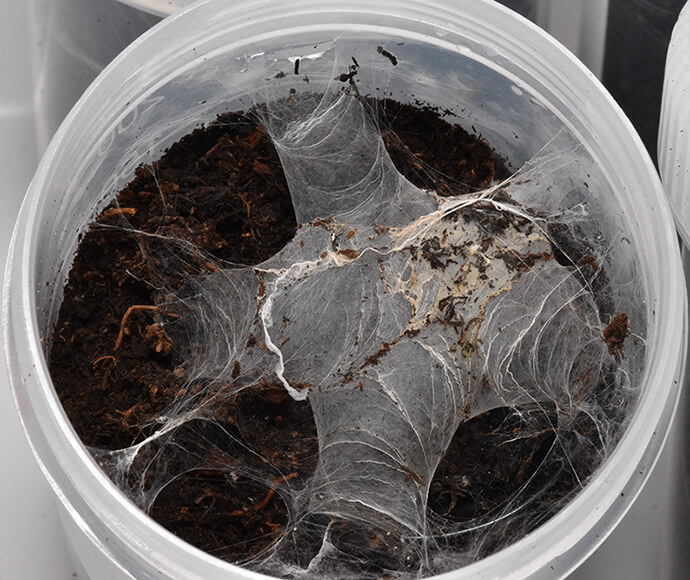
The funnel-shaped web of a Sydney funnel-web spider
Share your pictures
Share your pictures across social media and show us what you’re doing to help Sydney’s native plants and animals.
#sydneynature
#ilovesydneynature
#natureforall
Identify your spiders
It can be difficult to identify what species a spider belongs to. There are some easy options to work out which general type or genus of spider you’ve found.
iNaturalist is a webpage and app that enlists the help of others to help you identify a plant, fungus or animal. It uses sophisticated software that will suggest a species when you upload a photo.
Other useful webpages with good spider information include:
- Spiders of Australia – a website that shows common spiders.
- Spidentify – a fun interactive app that guides you through identifying Australian spiders, provides images, and information on behaviour, habitats and whether each species is dangerous or not.
- The Australian Museum has some great online fact sheets that include images and descriptions of different spiders habitats, diets, behaviours and maps of where they are found.
